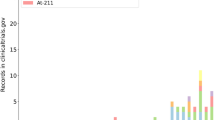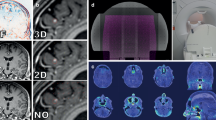Abstract
A radiation beam passes through normal tissue to reach tumor. The latest devices for the radiotherapy of cancer provide intensity modulated radiation treatment, or IMRT. This method refines cancer treatment by varying the intensity profile across the face of a radiation beam. Intensity modulation is usually accomplished by partitioning each beam, distinguished by its angle of entry, into an array of smaller sized units, called beamlets, assigned different intensities. Planning treatment calls for an optimization over beamlet intensities to maximize the dose delivered to the targeted tumor while keeping the distribution of dose throughout the various organs within physician prescribed bounds. The choice of beam angles can be entered into the optimization as well.
A common method to produce an intensity pattern is to block out different parts of the beam for different amounts of time. This can be done sliding narrow blocks (leafs) of unit width into the beam from either of two opposing sides to create different beam shapes called segments. A sequence of segments with their exposure times is superimposed to yield the dose distribution actually received in the patient. Current two stage treatment is derived in separate steps: optimization over independently considered beamlet intensities, and generation of a sequence of segments to approximate the planned intensity map. The approximation degrades the solution, and the separate search for segments adds to planning time. We present a mixed integer programming alternative employing column generation to optimize dose over segments themselves. Only segments that can be realized with delivery devices are generated, and adjustments made for the effects of block edges, so that the optimized plans are directly implementable. Preliminary testing demonstrates gains in both planning efficiency and quality of the plans produced.
Similar content being viewed by others
References
Bednarz, G., D. Michalski, C. Houser, M.S. Huq, Y. Xiao, P.R. Anne, and J.M. Galvin. (2002). “The Use of Mixed-Integer Programming for Inverse Treatment Planning with Pre-Defined Segments.” Phys. Med. Biol., 47, 2235–2245.
Bortfeld, T.R., D. Kahler, T.J. Waldron, and A.J. Boyer, (1994). “X-ray Field Compensation with Multileaf Collimators.” Int. J. Radiat. Oncol. Biol. Phys., 28, 723–730.
Boyer, A.L. and C.Y. Yu. (1999). “Intensity-Modulated Radiation Therapy with Dynamic Multileaf Collimators.” Sen. Rad Onc., 9, 48–59.
Chappell, R. and J.F. Fowler. (1994). “Steepness of Dose-Response Curve for Larynx Cancer (Letter).” Radiother. Oncol., 30.
Cotrutz, C. and L. Xing. (2003). “Segment-Based Optimization Using A Genetic Algorithm.” Phys. Med. Biol., 48, 2987–2998.
Dai, J.-R. and Y.-M. Hu. (1999). “Intensity-Modulation Radiotherapy Using Independent Collimators: An Algorithm Study.” Med. Phys., 26, 2562–2570.
Deng, J., T. Pawlicki, Y. Chen, J. Li, S.B. Jiang, and C.M. Ma. (2001). “The MLC Tongue-and-Groove Effect on IMRT dose Distributions.” Phys. Med. Biol., 46, 1039–1060.
Galvin, J.M., X.-G. Chen, and R. Smith. (1993). “Combining Multileaf Fields to Modulate Fluence Distributions.” Int. J. Radiat. Oncol. Biol. Phys., 27, 697–705.
Graham, M.V., J.A. Purdy, B. Emami, W. Harms, W. Bosch, M.A. Lockett, and C.A. Perez. (1999). “Clinical Dose-Volume Histogram Analysis for Pneumonitis After 3D Treatment for Non-Small Cell Lung Cancer.” Int. J. Radiat. Oncol. Biol. Phys., 45, 323–329.
Li, Y., J. Yao, and D. Yao. (2003). “Aperature Based Optimization for Static IMRT Using Genetic Algorithm.” abstract only, Med. Phys.
Perez, C.A., L.W. Brady, E.C. Halperin, and R.K. Schmidt-Ullrich. (2004). Principles and Practice of Radiation Oncology, 4 th edn., Lippincott, Williams and Wilkins, p. xix.
Preciado-Walters, F. (2003). “Optimal External Radiation Therapy Planning for Cancer: A Mixed-Integer Approach.” Unpublished Ph.D. Dissertation, School of Industrial Engineering, Purdue University.
Preciado-Walters, F., R. Rardin, M. Langer, and V. Thai. (2004). “A Coupled Column Generation, Mixed Integer Approach to Optimal Planning of Intensity Modulated Radiation Therapy for Cancer.” Mathematical Programming, 101, 319–338.
Que, W. (1999). “Comparison of Algorithms for Mutileaf Collimator Field Segmentation.” Med. Phys., 2390–2396.
Romeijn, H.E., R.K. Ahuja, J.F. Dempsey, and A. Kumar. (2005). “A Column Generation Approach to Radiation Therapy Treatment Planning Using Aperture Modulation.” SIAM J. Optim, 15, 838–862.
Shepard, D.M., M.A. Earl, X.A. Li, S. Naqvi, and C. Yu. (2002). “Direct Aperture Optimization: A Turnkey Solution for Step-and-Shoot IMRT.” Med. Phys., 29, 1007–1018.
Siochi, R.A. (1999). “Minimizing Static Intensity Modulation Delivery Time Using an Intensity Solid Paradigm.” Int. J. Radiat. Oncol. Biol. Phys., 43, 671–680.
Suit, H.D., S. Skates, A. Taghia, P. Okunieff, and J.T. Efirt. (1992). “Clinical Implications of Tumor Response to Radiation.” Radiother. Oncol., 25, 251–260.
Webb, S. and M. Oldham. (1996). “A Method to Study the Characteristics of 3D Dose Distributions eated by Superposition of Many Intensity-Modulated Beams Via a Slit Aperture with Multiple Absorbing Vanes.” Phys. Med. Biol., 41, 2135–2153.
Wu, Y., D. Yan, M.B. Sharpe, B. Miller, and J.W. Wong. (2001). “Implementing Multiple Static Field Delivery for Intensity Modulated Beams.” Med. Phys., 28, 2188–2187.
Xia, P. and L.J. Verhey. (1998). “Multileaf Collimator Leaf Sequencing Algorithm for Intensity Modulated Beams with Multiple Static Segments.” Med. Phys., 25, 1424–1434.
Xiao, Y. and J.M. Michalski Galvin. (2003). “The Least-Intensity Feasible Solution for Aperture-Based Inverse Planning in Radiation Therapy.” Annals of Operations Research, 119, 183–203.
Author information
Authors and Affiliations
Additional information
A portion of the work of Dr. Langer, Mr. Thai and Dr. Preciado-Walters was supported by National Science Foundation grant ECS-0120145 and National Cancer Institute 1R41CA91688-01.
Rights and permissions
About this article
Cite this article
Preciado-Walters, F., Langer, M.P., Rardin, R.L. et al. Column generation for IMRT cancer therapy optimization with implementable segments. Ann Oper Res 148, 65–79 (2006). https://doi.org/10.1007/s10479-006-0080-1
Published:
Issue Date:
DOI: https://doi.org/10.1007/s10479-006-0080-1




